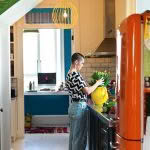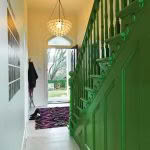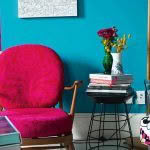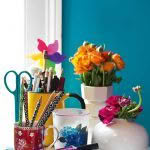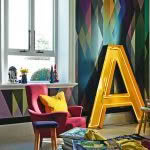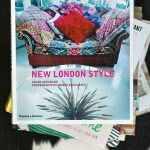The colourful life of Anya Brighouse
- Anya, Madeleine, Theodore and Riley under Ingo Maurer’s Bang Boom Zettel’z light fitting. The piece brings an art-inspired, graphic focus to the dining room as well as lighting the table for schoolwork or dinner.
- All the artwork in the kitchen is done by the children, including a hand painting by grand-daughter Zinnia.
- The colour on the stairs is Porters’ Grass. Anya has kept things in the hallway very simple as she wanted the stair colour to be the real focus of the space – it’s a way of adding a huge statement for only the price of the paint.
- The graphic black and white drawing by Theodore hangs next to a painting from Erin O’Malley. Underneath is an Ercol chair bought from Trade Me for $70 and recovered in a Marimekko fabric. The black stool/table is by Kiwi designer Timothy John.
- This colour combination of the pink chair and blue wall is Anya’s favourite.
- The Cole and Son Circus wallpaper is the focus for all of the colours in the house. Mark’s office is tucked away in the corner. The large A is from Flotsam & Jetsam and the pink chair is an $80 Trade Me find covered in pink linen. The yellow cushion was originally a sheet that Anya loved so much she had it made into a couple of cushions.
- “New London Style by Chloe Grimshaw is one of my all-time favourite books with beautiful fabric combinations and a relaxed, eclectic approach to design that I just love.”
There’s an element of Wonderland in interior designer Anya Brighouse’s home but this creative force is anything but out of control
Words: Tracey Strange Photos: Jane Ussher
This article was first published in the July/August 2016 issue of NZ Life & Leisure.
The kitchen table in Anya Brighouse’s home isn’t just for eating. Children do their lessons here; Ludo the labradoodle mooches for scraps (although, strictly, the almost preternaturally calm 10-month-old puppy isn’t allowed to); advice is dished out, stories told and lives shared over bowls of cereal and Sunday roasts. Etched into the grain of that wood, suede-smooth because it’s been around since the children were very young, is the warm, no doubt sometimes messy, handprint of a Kiwi family.
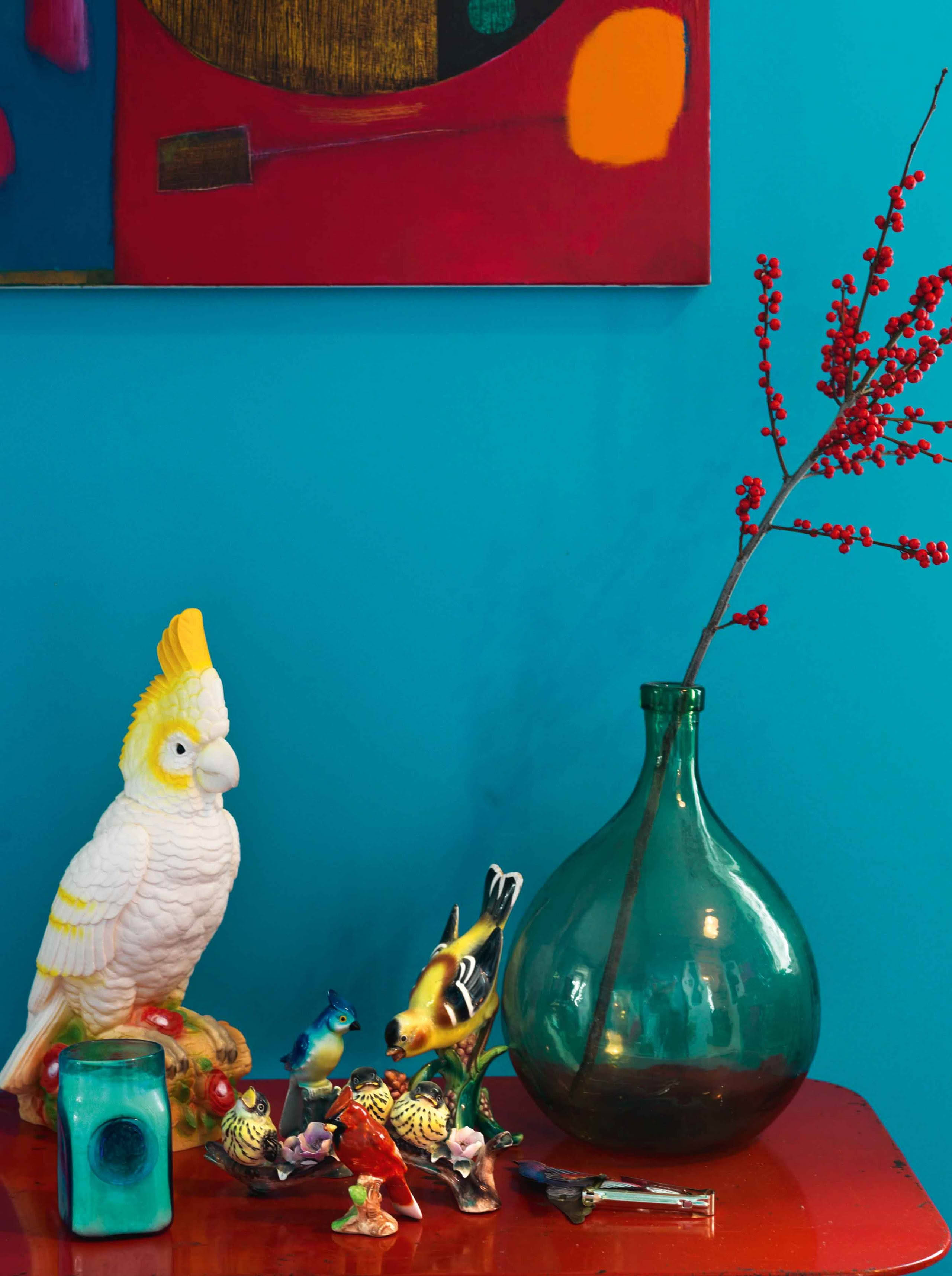
It’s the same with the walls, the sofas and the floors. Personality is in the art, on the bookshelves, in the rugs and certainly in the choice of colours. It would be impossible to walk into this house and not get a sense of who lives here. To pinch the words of poet Anthony Liccione: “Everyone needs a house to live in, but a supportive family is what builds a home.”
To really fix the picture, here’s an example. Art is everywhere but one detailed graphic, in particular, stands out. Curated on a wall with many others, it’s a line drawing of a townscape; scores of houses with sweet pointy roofs all piled on top of each other and linked by bridges and staircases. It is clever and intricate and bursting with energy. Figures can’t be seen. One senses that they are there behind those walls, going about their lives as people do. The artist is the Brighouses’ youngest son, Theodore, now 13. But a while ago he stopped drawing. The reason, his parents found, was that he had been told that what he did wasn’t real art. It was just doodling. It’s one of the reasons – but certainly not the only one – that he’s now home-schooled.
If creativity actually is intelligence having fun (thank you Einstein), the combined brainpower contained within the Brighouse walls is almost, but not quite, formidable. And yet for all its colour and texture and pattern and seemingly unfettered whimsy – for all its Wonderland-ness – the house is soothing. The combined effect of a multitude of creative layers isn’t to over stimulate, but to ground. When Alice fell through this particular rabbit hole she entered, not into a realm of mad hatters, disgruntled queens and grinning cats, but into a world of calm.
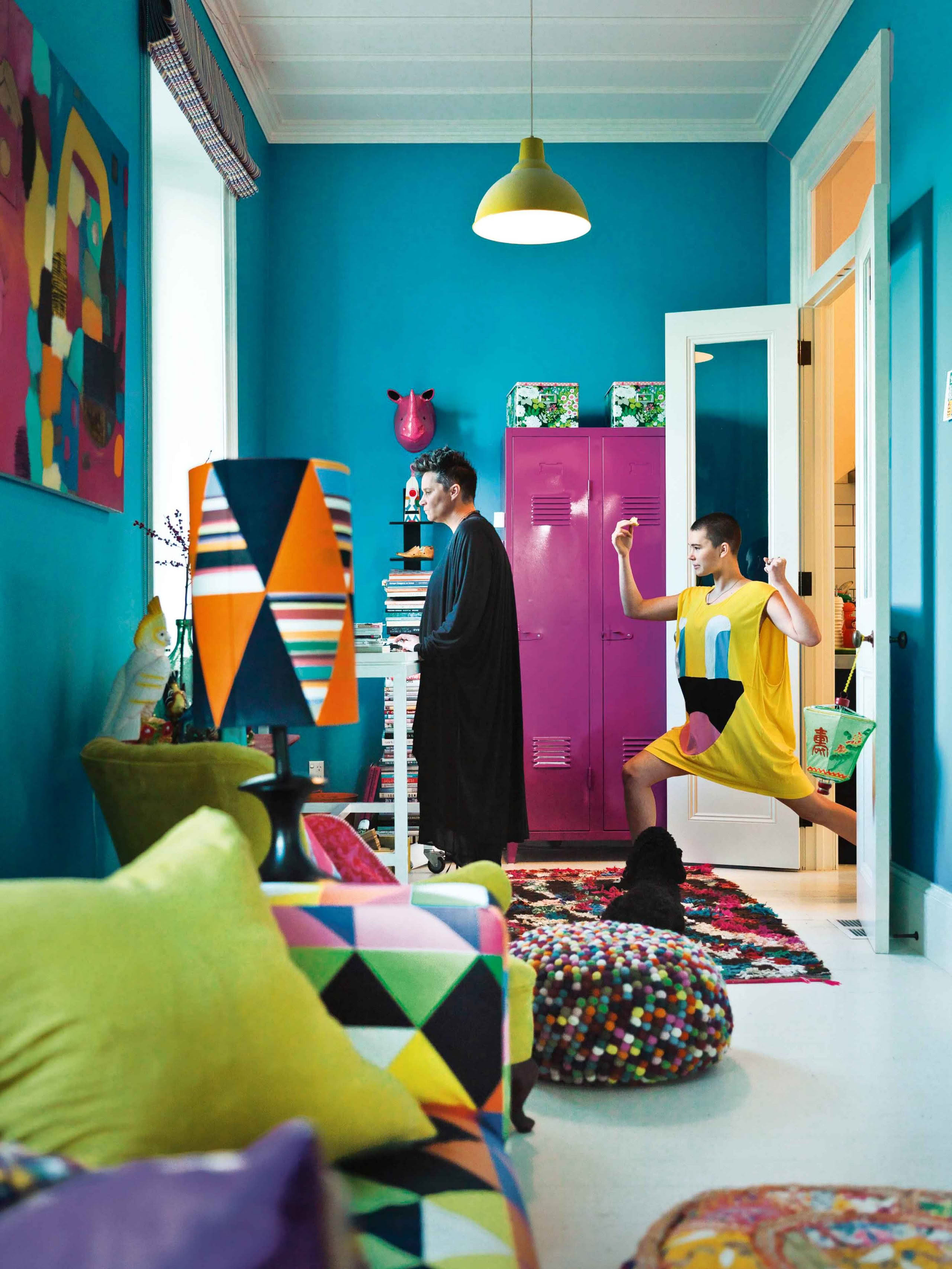
Anya has her home office tucked into an unused space in the lounge that leads off the kitchen. It means she is not far from the children while they study and her standing desk is easy to get to and use. “You don’t always have to have a separate space for an office when you can seamlessly fit it into a current space using the same palette and feel”, she says.
But maybe that’s because it’s a Saturday morning and the teenage boys are in their bedrooms, Ludo is on her very best behaviour, and dad’s taken the opportunity to have a kip on the couch. Interior designer Anya Brighouse – the woman probably most responsible for extracting calm from what could be chaos in a house full of teenagers, puppies and riotous colour – sits at her table, characteristically dressed entirely in black.

“There’s a bit of a story to Ludo,” she says, stroking the puppy’s dark ears. “A friend of ours also has a labradoodle called Pippi, who often comes to stay. Once, when one of the children was sick with a cold, Pippi stayed by her side, edging closer and closer and then crying until I realized the cold had turned to bronchitis. We spent eight hours at the hospital and Pippi laid by the front door, not moving an inch until we came home.
“When we decided to get a dog of our own we went straight to the same breeder. Each night Ludo rotates between sleeping with each of the children – we even built her some stairs so she can climb onto Theo’s especially tall bed. We call her our companion animal.”
A fondness such as this – for animals, people and things – seems to define the Brighouse household. Most of the artwork is either by one of the children, someone the family knows or has a story to it. Furniture is carted from one house to another, no-longer required cushions stored away until there is space for them, chairs given a new lease with a coat of paint. Few things have a use-by date; everything is savoured or repurposed and admired anew.
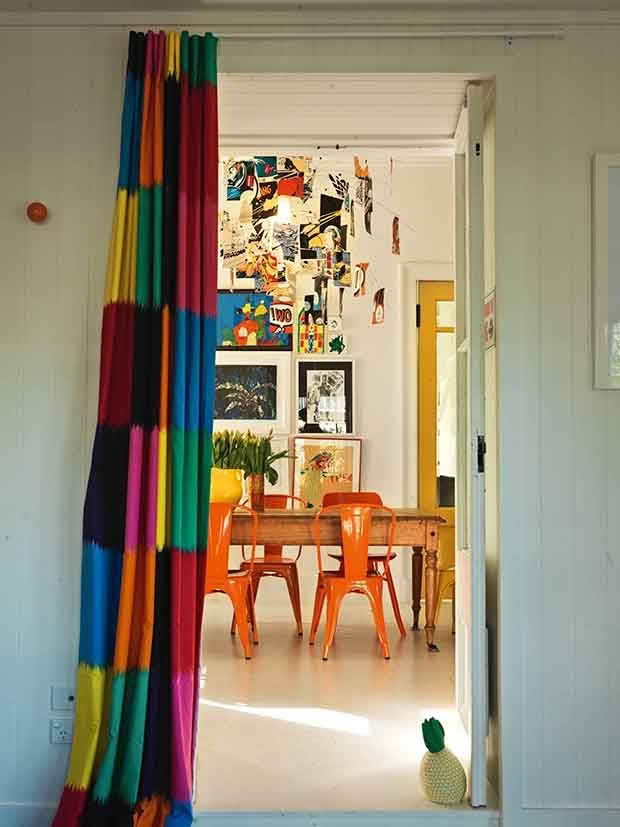
“While anything will work if you really love it, I think that interior trends are a bit like chocolate – you get an immediate hit when you buy (or in the case of chocolate, eat) it. But you have to live with the consequences.”
The daughter of a South African mother and a Welsh father who met in Johannesburg, were married four months later and came to New Zealand as part of a programme to encourage new immigrants, Anya grew up in Kawerau and had a “wonderful, uncomplicated upbringing”. But it certainly wasn’t without style. “My mother had travelled a bit and had quite a Continental approach to design,” she says.
“We lived in a house filled with pieces she loved. But while she liked simple – we had an oatmeal carpet, which was really difficult to find in the 1970s when everyone else had patterned Axminster – she also understood colour. We had one standout chair in bright orange that would literally make people stop, and I was allowed to decorate my room in apple green and purple. My love of fabrics started with her.”
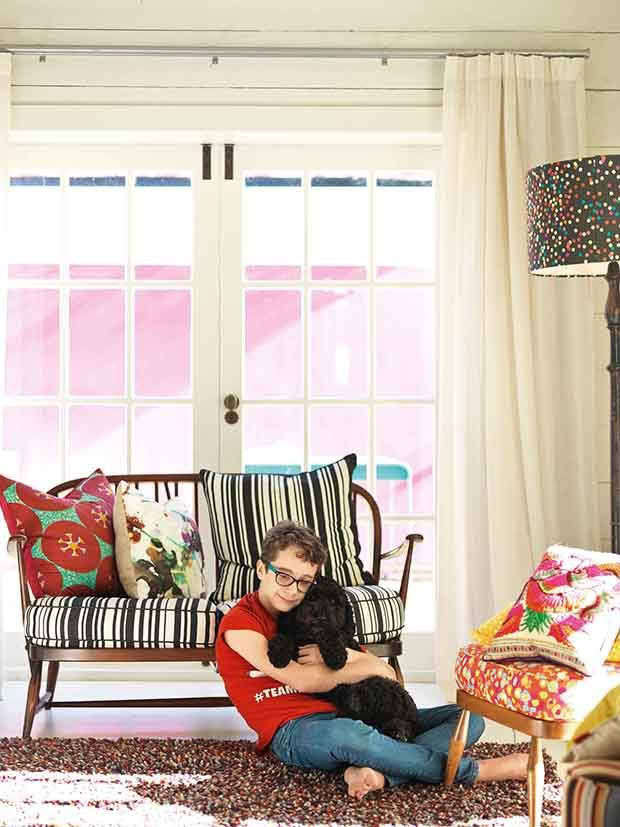
Initially she wanted to be an artist, but she grew up in the age of the women’s movement. It was the responsibility of girls, the rhetoric went, to use their brains – to be able to support themselves with a career – and so she gave herself a “proper” occupation by studying to be a teacher.
“I would have chosen child psychology but a guidance counsellor told me I was shooting too high,” she says wryly. Perhaps not unexpectedly under the circumstances, she finished her teachers’ training but never did go on to teach. And although she did work with teenagers for a while, it was art – or design – that continued to pull at her heartstrings. As did a man called Mark.
At 26, she met Mark Brighouse and they married two years later. Madeleine, their daughter, now 19, was born while the couple were living in England. “I had three years in London before Madeleine was born to wander round and soak it all up. I discovered shops like Designers Guild and Habitat and they really changed my viewpoint. I found good design that was beautiful and affordable.
“We also did up houses and then sold them and friends started to ask me to help them decorate a room or renovate a kitchen…”
She was pregnant with Riley (now 17) when the family returned to New Zealand and after a spell as a full-time mum she started her own small interiors business designing children’s rooms.
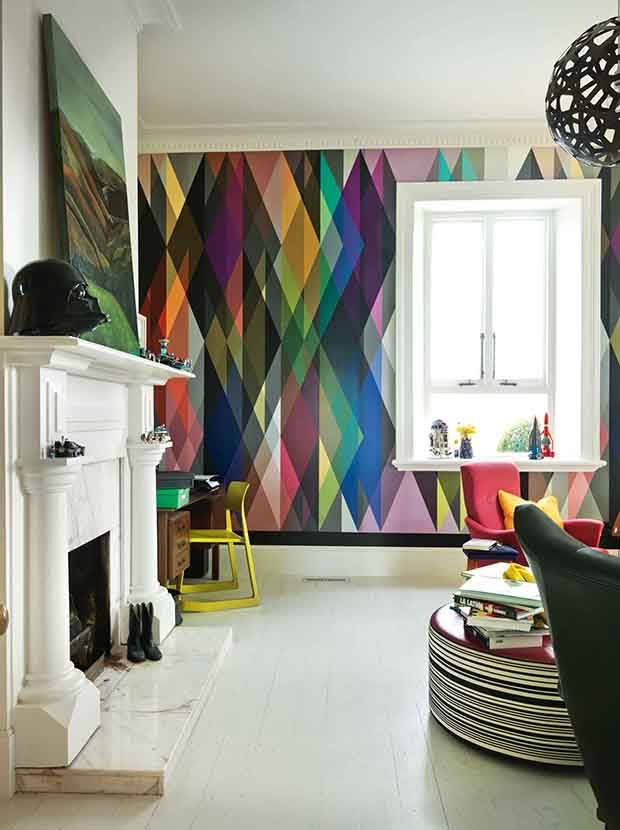
“I figured that if I was going to be away from the children for any time it had to be doing something fun – and children’s rooms are just that,” she says. “You can be so much more adventurous with colour.” Now her consultancy, developed over the years by word of mouth, includes commercial as well as residential clients and is more likely to involve renovating a whole house rather than a single room. “But I like going room by room,” she says. “Designing a house slowly means you really know where you are headed.”
She also isn’t quick to suggest that a sofa be discarded or a wall be knocked down. “There’s always a clever way to work with what you have. I’m the last person to tell you to throw something away,” she says pointing to a painted stool.
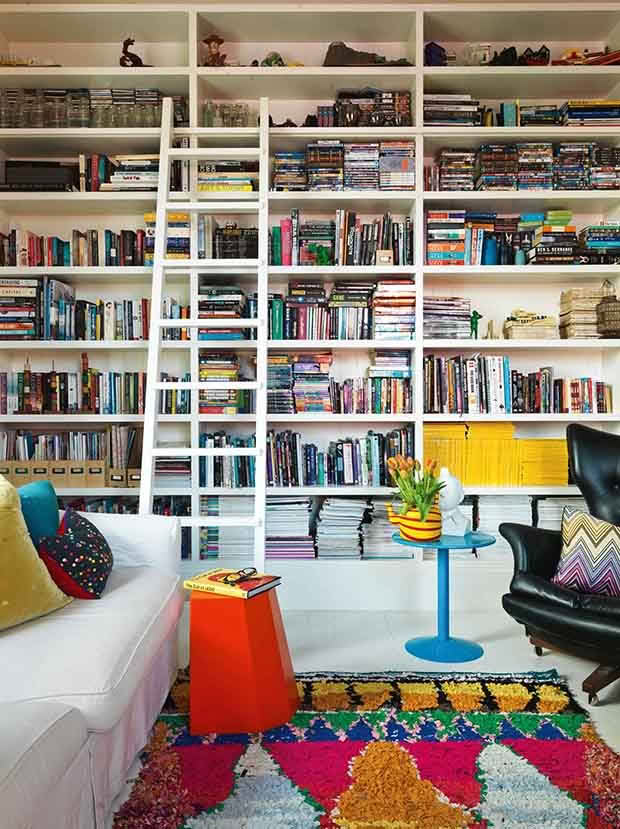
“That stool was in our house when we were children. I found it in my brother’s garage, where it was supporting his weights, and rescued it. It’s yellow now but it’s been many colours.
“I have this theory,” she says, “that New Zealanders move too much. We tend to need houses for psychological phases in our lives – a flat section when the children are really young, for example, and then – five to seven years later – a house with enough space for them to be with their friends or do their homework. And then there will be another phase as they get older or move out. The thing is to try and catch those phases before they happen and plan ahead with a renovation. Moving costs a lot of money, and we need to be a bit more clever with what value and how we live. Size – or a bigger house – is not in itself cleverness.”
She is, she thinks, a bit of a contradiction. “While I’ve realized over the years that I am creative, I am also really drawn to order. I like the succinctness and practicality of good design.”

So much so that she now likes to write about it in not one but two blogs. The first Beautiful Bedlam is about Anya’s life as an interior designer, the remodelling of her 1865 heritage Auckland home, and the chance to indulge her love of colour and texture. The second is Beautiful Black, where she writes on fashion (she worked for fashion label Keith Matheson for many years before marrying Mark), particularly her obsession with noir. Unexpectedly for someone who lives in a world dominated by colour, Anya will only wear black.
“Wearing colour makes me feel like I stand out,” she says with a small but perceptible shudder. “So I wear all black, mostly New Zealand-made and usually designed by someone I know.”
Creativity is a powerful force. For some it’s an outlet, for others a way of life. But it has its price. “Creativity costs you,” she says. “It’s not never-ending. I really believe that. You have to work out where you want to use it.”
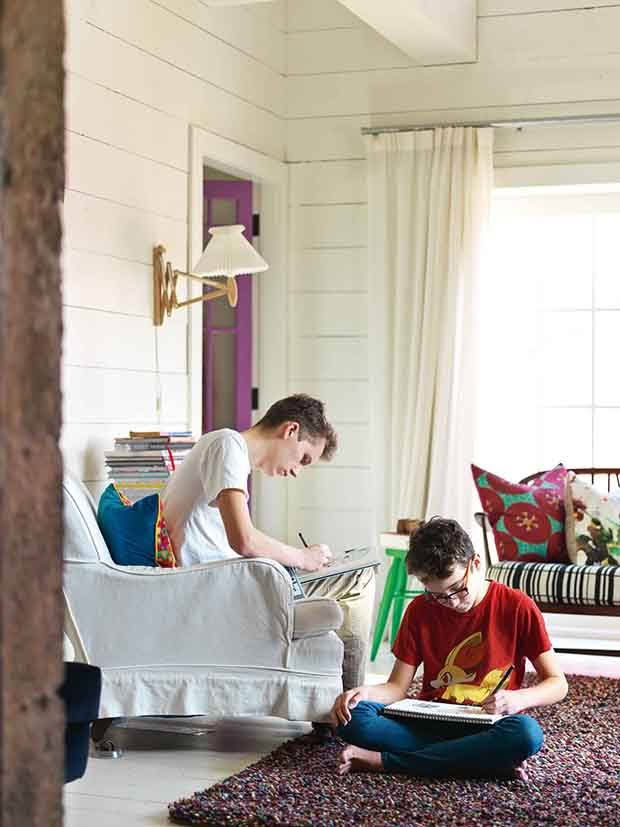
THE BUSINESS OF BEING ANYA
“Who’d spend a lot of money on a cushion?” says Anya. “Well, me actually.” Cushions, she says, are one of the quickest and easiest ways to bring a room together or refresh an existing look. But the fabrics don’t have to be costly. The key is to choose what you love. Think of them as beautiful accessories and never throw them away. That’s one Brighouse tip. Here are others:
● Good design doesn’t have to be about money; you can find great things at Kmart or an op shop for that matter. “The key is in finding value. It’s a bit like cost per wear with shoes – if you buy well and keep them, the cost is spread out.”
● Avoid copies or reproductions. “They instantly devalue. Buy once and buy well.”
● Look for value in different things. An example is children’s artwork, a lot of which is framed beautifully and on show in the Brighouse home.
● Don’t buy to suit a single space in the house, she says. Buy an item because you love it and be prepared to keep it and move it around, even if it means repainting
or reupholstering.
● If you move, take it with you. If you loved it in the first place, it will always work somewhere or it can be stored until you find a home for it.
Love this story? Subscribe now!
 This article first appeared in NZ Life & Leisure Magazine.
This article first appeared in NZ Life & Leisure Magazine.

